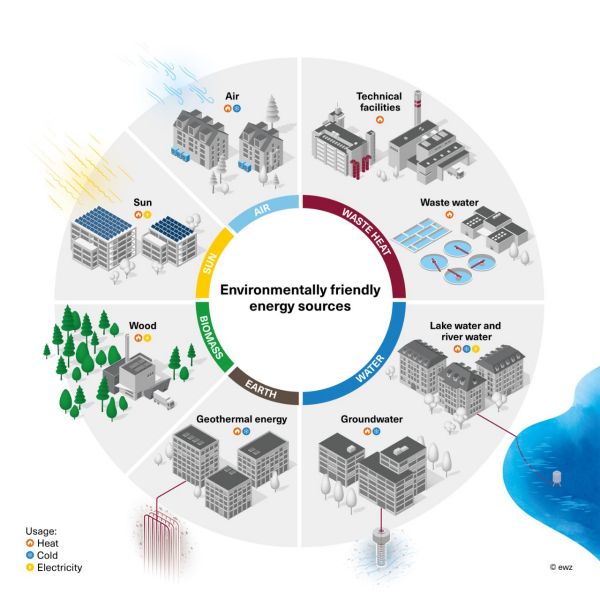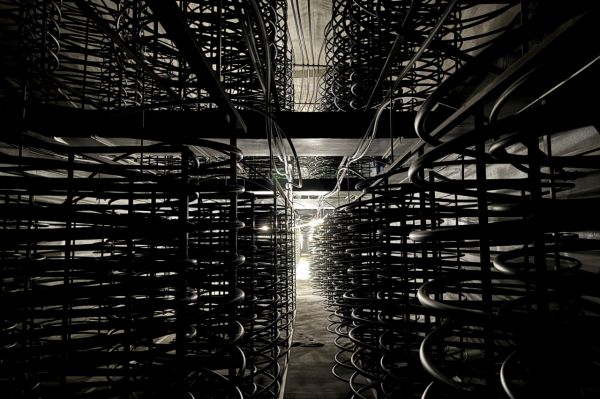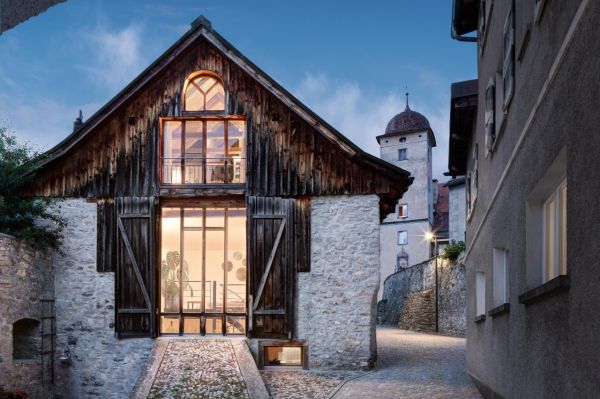

More and more buildings in Switzerland are connected to a district heating or cooling network. This refers to a particularly efficient supply system in which the heating or cooling energy is not produced where it is consumed. The thermal energy, whether heat or cold, is transported via a pipeline system from the place of generation to the connected buildings. Water is usually used as the carrier medium.
The advantages of district heating are convincing: The system is space saving and convenient. The use of local, climate-friendly energy sources fulfils legal requirements. The bundling of plants and infrastructures leads to economies of scale that reduce energy production costs.
The first district heating system was built on Josefstrasse in Zurich almost 100 years ago. It used the waste heat from the waste incineration plant to heat various properties in the area. In the years that followed, numerous other projects were added throughout the country. However, the potential of district heating is by no means exhausted: according to the federal government’s Energy Perspectives 2050+ (in German), heat production could be increased from around 8 TWh per year today to up to 18 TWh per year.

The district heating networks make it possible to tap various renewable energy sources that otherwise could hardly be exploited economically. It is also possible to combine different energy sources to supply a district heating network. In this way, security of supply and efficiency can be increased.

District heating offers the opportunity to decarbonise entire sites and districts. This makes it an essential component of Switzerland’s future heat supply that, according to the Swiss net zero target, is to be climate-neutral by 2050 at the latest.
The principle of district heating is that energy is produced centrally in a heating or energy network and delivered to consumers via pipes – usually in the form of water. This is often referred to as district heating. District heating networks can be divided into high-temperature and low-temperature networks on the basis of their operating temperature.
High-temperature network
If district heating is supplied at temperatures between 60°C and 150°C, this is referred to as a high-temperature network. These operating temperatures make it possible to heat a building using a heat exchanger alone and to supply it with hot water, without the need for further technical systems. High-temperature networks often use waste heat from waste incineration plants or heat from wood chip furnaces as an energy source. However, it is also possible to raise ambient heat at a lower temperature to the required temperature level using a heat pump. High-temperature networks demonstrate their strengths above all where the recipients require heating with high flow temperatures, hot water or process heat. In such cases, it is more efficient and cost effective to generate the required temperatures centrally rather than separately for each building.
Low-temperature networks
District heating networks with an operating temperature below 60°C are based on a decentralised supply structure. The thermal energy is raised to the required temperature locally at the recipient because the temperatures are too low for a direct supply. The increase in temperature is usually carried out by a heat pump. Although low-temperature networks are somewhat more technically demanding, they offer more flexibility. They are useful in areas where users require different supply temperatures, such as in areas with new and existing buildings. Another advantage is that users with internal cooling processes – such as an industrial or commercial enterprise – can also feed waste heat into the grid, which would otherwise disappear unused.
If the operating temperature of a low-temperature network is below 20°C, connected buildings can be cooled directly. In this method, known as ‘free cooling,’ cool water is pumped through the heating pipes in the building, which can cool the rooms by 2°C to 3°C. Ambient heat, for example from groundwater, lakes or rivers, is the most suitable energy source for low-temperature networks.

If thermal energy is only transported over short distances, this is also referred to as local heating or cooling. The way it works, however, is the same. The generic term ‘thermal network’ summarises this energy supply principle and is mainly used by experts.
If there are different uses on a site or a development, such as residential, commercial and services, it is usually necessary to not only heat but also cool. District heating and cooling networks can be easily incorporated into integrated energy solutions. If a low-temperature network takes on this task, interesting synergies emerge. For example, waste heat from buildings that require cooling can be used for heating elsewhere.
The combination with photovoltaics (PV) is attractive: if heat pumps can be operated with your own solar power, this reduces operating costs and increases the self-consumption of the PV system at the same time. For such an integrated energy solution to work efficiently, it must be planned holistically from the outset.
Ice hockey stadium as a best-practice example
ewz has already successfully implemented this approach in various projects. One example of this is the energy concept of the Swiss Life Arena. The locally produced air conditioning for the ZSC Lions stadium can be made available to other residents in the immediate vicinity. The resulting waste heat serves as an energy source for the Altstetten district heating network. A large photovoltaic system on the stadium roof provides renewable electricity for the technical systems. This comprehensive concept enables an environmentally friendly, secure and economical energy supply to the site and its surroundings.
For a district heating network to operate economically, certain conditions must be met.
Networks pay off in densely populated areas
As a general rule, the more densely populated, the higher the heat demand per unit area and the shorter the pipe length, the more economically an area can be supplied with district heating. These criteria apply in particular to urban areas. According to a study (in German) by Empa, ETHZ and HSLU, supply via a district heating network makes sense in terms of energy as well as economically in 50 per cent to 80 per cent of urban districts and in up to 50 per cent of densely populated agglomeration municipalities.
But it is also possible in the countryside
However, this does not mean that other locations may not also be suitable. Relevant aspects include the availability of a low-cost renewable energy source and the building conditions. In cities in particular, the cost of implementing infrastructure is often high because space is limited and many pipelines are already installed underground. In this respect, rural communities often have an advantage: district heating networks can usually be implemented faster and at lower costs. One example of this is the municipality of Ilanz, where ewz commissioned a wood-fired combined heat and power plant and the Ilanz district heating network in 2014.
A comprehensive assessment is required
To assess the economic viability of a district heating network, it is always necessary to take a holistic view. This also includes weighing up risks such as rising energy prices, reduced heating requirements or rising interest rates for potential borrowed capital. It must also be checked whether the conditions for subsidies that are granted in many cantons for the construction and expansion of district heating networks are met. It is important to develop a suitable tariff model for the profitability of the company. Three-tier models are often used, consisting of connection costs, a basic annual contribution and energy costs.

Heat storage systems are an important component in the safe, environmentally friendly and efficient operation of district heating networks. They serve as a buffer and make it possible to coordinate heat production and demand. Depending on the type and size of the storage system, the energy can be stored for days, weeks or even months.
Cover peak loads with energy storage systems
Heat storage systems can significantly increase the efficiency of heat generators by taking over part of the output during peak loads, for example. At the same time, they can reduce peak load coverage by gas or oil boilers or replace them entirely, thus contributing to the decarbonisation of district heating networks.
Seasonal storage systems absorb excess renewable heat in summer and make it available again in winter. They reduce the need for fossil fuels and the amount of electricity drawn from the public utility grid, thus making an effective contribution to a secure electricity supply in winter.
Storage types
Different types of thermal storage systems are possible for a district heating network. Geothermal probe storage, for example, is good for combining with low-temperature networks as it can supply thermal energy for both heating and cooling. It can be operated on a short-term and seasonal basis.
Container heat storage systems such as prefabricated steel tanks or concrete storage tanks built into the ground store water at high temperatures. They are suitable for high-temperature networks and are mainly used for short-term storage. Lucerne University of Applied Sciences and Arts (in German) is currently researching how existing cavities – such as disused bunkers or cellars – can be insulated and used as heat storage.
Ice reservoirs are also an interesting option. They are not preheated or heated and instead use the thermal energy released when water is frozen. Find out more about energy storage systems in our white paper.

If a city, municipality or site management body wants to implement a district heating network in their area, the first step should be to check whether the decisive criteria have been met. The key question is whether there are enough users in the planned area to run the project economically. In addition, suitable renewable energy sources are needed in the vicinity that can be accessed as easily as possible.
Review collaboration with specialist partners
For further planning, it is advisable to work with a competent specialist partner. ewz has been planning, financing, building and operating heating and energy networks in urban and rural areas throughout Switzerland for more than 20 years. Find out about our services for municipalities and cities and about the possibilities of working with ewz.
Prepare the connection
Owners who want to connect their property to an existing or planned district heating network are best advised to contact the network operator. Switching from a locally installed heating system to a grid connection is usually easy. For this purpose, a connection is made to the building from the district heating pipe. All that is needed in the building itself is a district heating transfer station with a heat exchanger that transfers the thermal energy from the district heating circuit to the property’s heating water circuit. Compared to a conventional heating system, the grid connection reduces both maintenance and space requirements.

Recommended reading: anyone looking for further information on district heating will find what they are looking for in the ‘Thermische Netze’ (Thermal Networks) issue from Faktor Verlag. The publication shows how such networks work, what different types there are and what needs to be considered when planning. Exciting real-world examples serve as inspiration for municipalities, building owners and investors who want to implement a district heating or cooling project.


The following ewz projects illustrate how district heating networks can be implemented in practice and the benefits they offer:
Waste heat from waste water: Zurich-Altstetten energy network
The wastewater treated in the Werdhölzli sewage treatment plant has a temperature of 11°C even in winter, making it an ideal local energy source for a large district heating network in Zurich-Altstetten.

Waste heat from waste incineration
The waste incineration and wood heating network is of critical importance for Zurich. Numerous private property owners and institutions such as the University Hospital Zurich rely on a reliable energy supply from waste heat and heat from the Aubrugg wood-fired combined heat and power plant every day.

Wood-fired CHP plant Ilanz district heating network
Together with the municipality, ewz has been operating a district heating network in Ilanz since 2014, which is supplied with thermal energy from a wood-fired combined heat and power plant. The wood comes from the region, so the transport routes are very short and therefore environmentally friendly.

Wood-fired CHP plant Tavannes district heating network
In the municipality of Tavannes in the Bernese Jura, ewz has been operating a wood-fired district heating network since 2015. It supplies various municipality-owned properties and residential buildings with climate-friendly, regionally produced heat in an economical way.

Lake water CoolCity
To provide buildings in downtown Zurich with a climate-neutral supply, ewz will be building various district heating and cooling networks in the coming years as part of the ‘CoolCity’ project. What they have in common is that they use lake water as an environmentally friendly source of energy.

Combination of waste water and wood: Fehraltorf district heating network
The example of Fehraltorf shows that a district heating network can be implemented not only in a city but also in a rural community. The network is supplied with waste heat from a wastewater treatment plant and a wood-fired combined heat and power plant.







